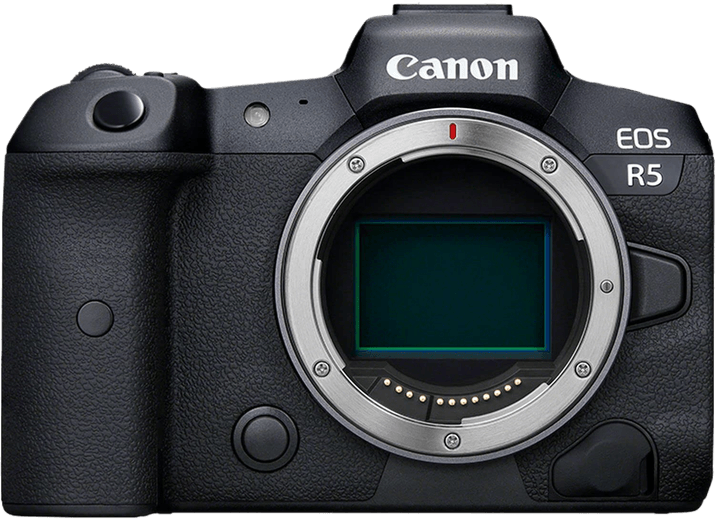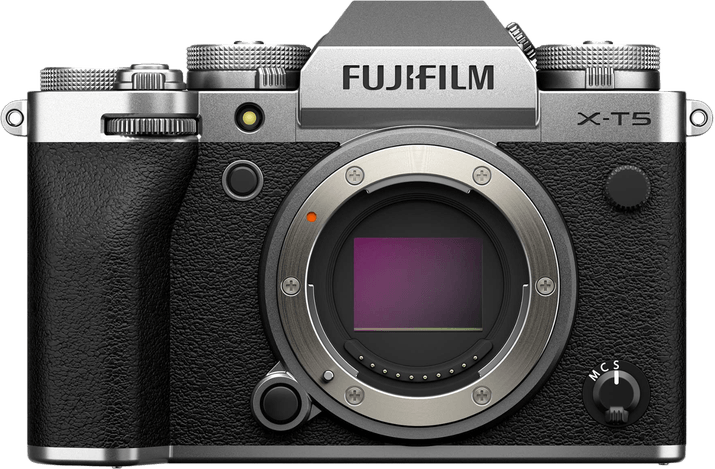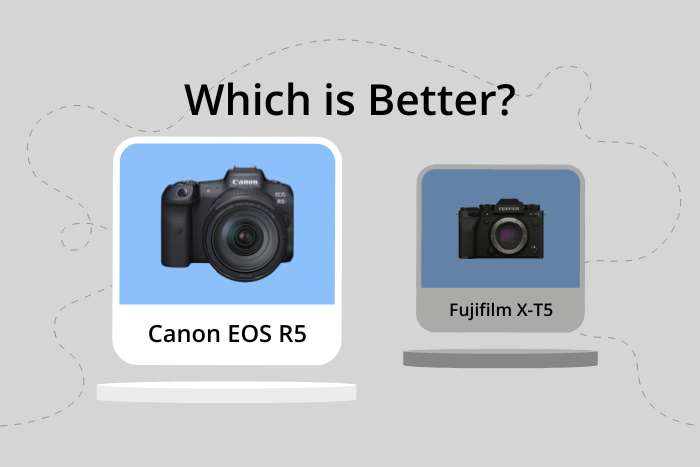Canon EOS R5 vs Fujifilm X-T5 Comparison
Canon EOS R5

Fujifilm X-T5

The Canon EOS R5 outperforms the Fujifilm X-T5 with a score of 86/100 compared to 81/100. Both cameras are mirrorless and share similar announcement dates, with the EOS R5 released in 2020 and the X-T5 in 2022. The two cameras have different sizes and weights, with the EOS R5 being larger at 138 x 98 x 88mm and heavier at 680g, while the X-T5 is smaller and lighter at 130 x 91 x 64mm and 557g.
The EOS R5’s higher score highlights its superior performance, making it worth the higher launch price of $4499. Its larger size and weight may offer better stability and durability. On the other hand, the Fujifilm X-T5 has its advantages with a lower launch price of $1699 and a more compact, lightweight design, making it easier to carry around.
Considering these factors, the Canon EOS R5 is the better choice for those seeking top performance and durability, while the Fujifilm X-T5 is suitable for those prioritizing affordability and portability.
Canon EOS R5 vs Fujifilm X-T5 Overview and Optics
The Canon EOS R5 takes the lead in optics with a score of 88/100, while the Fujifilm X-T5 trails behind at 81/100. Both cameras share several common specifications, such as a CMOS sensor, image stabilization, and similar processors – Digic X for the Canon and X-Processor 5 for the Fujifilm. However, the Canon EOS R5 outperforms the Fujifilm X-T5 in a few key areas.
Firstly, the Canon EOS R5 has a higher megapixel count of 45, compared to the Fujifilm X-T5’s 40. This difference allows the Canon to capture more detail in images. Additionally, the Canon EOS R5 boasts a faster shooting speed of 20 frames per second, while the Fujifilm X-T5 manages 15 frames per second. This advantage makes the Canon better suited for action and sports photography.
Another significant difference between the two cameras is the sensor size. The Canon EOS R5 has a full-frame sensor, while the Fujifilm X-T5 has an APS-C sensor. Full-frame sensors generally provide better image quality, particularly in low-light situations. Furthermore, the Canon EOS R5 has a DXOMARK score of 95 for its sensor, showcasing its superior performance. Unfortunately, DXOMARK does not score Fujifilm cameras, so a direct comparison is not possible.
On the other hand, the Fujifilm X-T5 does have its unique lens mount, the Fujifilm X mount, which offers a wide range of compatible lenses. However, the Canon EOS R5 also has a dedicated lens mount, the Canon RF, which similarly provides numerous lens options.
Taking all these factors into account, the Canon EOS R5 emerges as the superior camera in terms of optics. While the Fujifilm X-T5 does have its merits, the Canon’s higher megapixel count, faster shooting speed, full-frame sensor, and better DXOMARK score make it the clear winner in this comparison.
Canon EOS R5 vs Fujifilm X-T5 Video Performance
The Canon EOS R5 outperforms the Fujifilm X-T5 in video capabilities with a score of 100/100 compared to the X-T5’s 87/100. Both cameras share some common features, such as built-in time-lapse functionality. However, the EOS R5 excels in other areas, making it the better choice for video.
The Canon EOS R5 offers a higher maximum video resolution of 8K (8192 x 4320), while the Fujifilm X-T5’s maximum resolution is 6K (6240 x 4160). This means the EOS R5 produces sharper and more detailed video output. Additionally, the EOS R5 boasts a maximum video frame rate of 120fps, double the X-T5’s 60fps. This allows the EOS R5 to capture smoother slow-motion footage, providing more creative options for videographers.
Despite its lower video score, the Fujifilm X-T5 still has some advantages. Its 6K video resolution is still impressive and sufficient for most professional applications. Furthermore, the X-T5’s lower maximum frame rate of 60fps may be adequate for many users who do not require extreme slow-motion capabilities.
Considering the differences in video performance, the Canon EOS R5 emerges as the superior choice for videographers seeking higher resolution and faster frame rates. However, the Fujifilm X-T5 remains a competent option for those who prioritize other features or have a lower budget, while still requiring professional-level video quality. The final decision will depend on individual needs and preferences, but the EOS R5’s video capabilities undoubtedly surpass those of the X-T5.
Canon EOS R5 vs Fujifilm X-T5 Features and Benefits
The Canon EOS R5 emerges as the winner in this comparison with a feature score of 87/100, while the Fujifilm X-T5 trails close behind with a score of 85/100. Both cameras share several specifications, including touchscreen capabilities, flip screens, the absence of GPS, and the presence of WIFI and Bluetooth connectivity.
The Canon EOS R5 outshines the Fujifilm X-T5 in a few areas, most notably in screen size and resolution. The EOS R5 features a 3.2-inch screen, which is larger than the X-T5’s 3-inch display. Additionally, the EOS R5 boasts a higher screen resolution of 2,100,000 dots, compared to the X-T5’s 1,840,000 dots. This difference results in a crisper and more detailed image preview on the EOS R5, providing an enhanced user experience.
On the other hand, the Fujifilm X-T5 has its own merits, despite its lower feature score. The X-T5 is an excellent choice for photographers who prefer a more compact and lightweight camera. Its smaller screen size contributes to a more portable design, which can be an advantage for those who need to travel or carry their camera for extended periods.
Taking these factors into account, the Canon EOS R5 proves to be a superior camera in terms of features, offering a larger and higher-resolution screen. However, the Fujifilm X-T5 remains a strong contender for photographers who prioritize portability and a more compact design. Ultimately, the choice between the two cameras will depend on individual preferences and specific shooting requirements.
Canon EOS R5 vs Fujifilm X-T5 Storage and Battery
The Fujifilm X-T5 outperforms the Canon EOS R5 in storage and battery, scoring 76/100 compared to the R5’s 68/100. Both cameras share essential specs, such as two memory card slots and USB charging compatibility. However, each camera has its advantages.
The X-T5’s superior battery life of 580 shots, compared to the R5’s 320 shots, contributes to its higher score. Additionally, the X-T5 uses an NP-W235 battery, which lasts longer than the R5’s LP-E6NH battery.
On the other hand, the Canon EOS R5 accepts both SD/SDHC/SDXC (UHS-II compatible) and CFexpress memory cards, providing more storage options. The Fujifilm X-T5 only accepts SD/SDHC/SDXC (UHS-I compatible) memory cards.
To conclude, the Fujifilm X-T5 offers better battery life, while the Canon EOS R5 provides more versatile storage options. Both cameras have their strengths, and users should consider their specific needs when choosing between these models.
Canon EOS R5 vs Fujifilm X-T5 Alternatives
Still unsure whether Fujifilm or Canon is the right mirrorless model for you? Well, you’re not alone. Deciding on a camera brand is hard enough. We have articles comparing Fujifilm vs Canon, Fujifilm vs Sony, Fuji vs Olympus, and Canon vs Sony Mirrorless Cameras. You can also check out some more trending camera comparisons:

